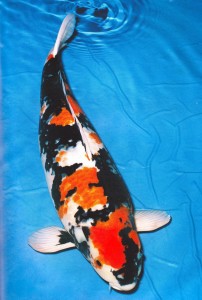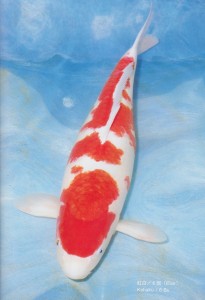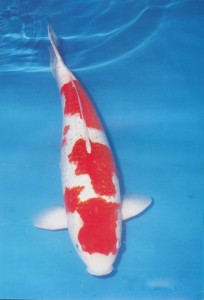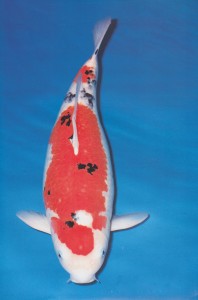It’s amazing just how long I have been preaching about hikui & shimi coming from filthy filters and just how much longer others have been putting it all down to genetics or bloodlines?
(For those who may be unaware, Hikui is a form of skin cancer that only affects the red pigment – generally on Kohaku, Sanke and Showa varieties. Visually it’s a raised yellow-ish lump, it is not contagious and nor does it affect the health of the Koi. But because it is unsightly and cannot be removed successfully, the Koi is no longer fit to be entered into Koi shows. This problem can devalue an expensive Koi into a ‘pond-filler’ – overnight.
Shimi translates as ‘freckle’ and appears on the Koi as small black spots. With luck some can be removed by human intervention whereas others cannot. Again this is not contagious and nor does it affect the health of the Koi. Shimi can also devalue an expensive Koi into a ‘pond-filler’ overnight.)
Here are a few shots of some very expensive Koi taken in the early 1970’s where hikui has been attempted to be scratched away before the photos were taken and published in a book later –




(If you look closely at these shots, you can see many appearances of hikui on these Koi. Aside from this, the entire appearance is dull and lack-lustre.)
But in Japan back in those days, Koi keepers were still in their infancy and gradually many Koi soon became new additions to the traditional Japanese garden goldfish pond.
The only people qualified to build these expensive garden landscapes were the landscape gardeners who knew exactly how to build and maintain a masterpiece.




Sadly, these very talented landscapers knew nothing about the Koi themselves or their requirements – and even less about the need for correct pond design and filtration.
They simply built a few large concrete boxes, hooked them up to pond side-wall feeds (there were no bottom drains back then), filled them full of assorted gravels – added a couple of pumps and finally turned the mains water tap on full bore.
The perfect recipe for disaster!
It took many years for the penny to actually drop that they needed –
a. EITHER to have a beautiful Japanese garden feature.
b. OR a dedicated Koi pond.
Those who wanted a dedicated Koi pond sent their builders up to Yamakoshi to copy (brick for brick) the systems the breeders used up there then returned to build the same thing for their clients.




Trouble was, very little actually changed afterwards, because after some time, hikui reared its head once more and this is simply because they didn’t know they actually had to CLEAN these filters periodically!
Incidentally, by then the UK was far ahead of Japan when it came to correct Koi pond design, build and maintenance procedures.
Moving forward to ’79.
By then vast numbers of Japanese ‘quality’ Koi enthusiasts threw in the towel simply because their Koi collections were constantly being de-valued by hikui and very soon the Japanese domestic market became reduced to buying general-grade tateshita.
That’s except for some wealthy and dedicated stalwarts who wanted the best quality Koi and could afford the best quality Koi. But in order not to duplicate their past mistakes – decided to keep all their best quality Koi with the breeders themselves.
The Koi kept by the Japanese breeders did not suffer with these problems.
The sole reason for this, is that the Koi breeders clean and disinfect their ponds, filter chambers and filter media thoroughly every nine months – immediately after their Koi stocks have been placed in the field ponds.
And still the hikui/shimi problem continues today in enthusiast’s ponds all over the world.
Once-avid Koi enthusiasts give up the hobby through frustration and others come into the hobby – soon to face exactly the same frustrations.
The main reason I designed my filter systems is because I genuinely believe they could prevent these problems ever arising again.
If you bear in mind that it’s extremely rare one can detect these problems arising in systems that are less than 30-months old and it’s only after that 30-month period they start.
My filter systems have been running on some ponds for over 48 months now – many of these ponds were previously plagued with hikui problems – still no new traces of these problems can be seen since then.
(I hasten to add that my filters are not ‘magic’ in any way but they can be kept as brand new daily in only seconds with the minimum wastage of water.)
ALL filter systems can prevent new outbreaks of these problems providing the filters are cleaned – thoroughly and regularly.
a. ‘Thoroughly’ means emptying them completely to waste.
b. Cleaning out the insides of the housings.
c. Cleaning all the filter media then replacing it all into place.
d. Then finally filling up and turning on the pump.
And therein lies the problem, the problem of time taken to do all this and the wait for new water to fill the system back up before pumps can be switched on again.
As mentioned earlier, MY filters can do all of this on a daily basis (if needed) in seconds!
And that’s the truth of it all – it’s got absolutely nothing at all to do with genetics or bloodlines.
But it IS a super excuse – isn’t it?
Hikui and Shimi CAN now be prevented on all Koi – irrespective of quality, variety or price paid.
Hikui and shimi are simply skin-surface blemishes.
Prevent these from happening again and your entire Koi collection will improve dramatically.
A final thought relating to the ‘SuperKoi’ we see today at the world’s major Koi shows.
You will not see a trace of Hikui or Shimi on these Koi because the vast majority of entries have been transported to the show directly out of the breeder’s water and will be returned there after the show.
The skin condition is superb – as is the lustre.
Waddy.






